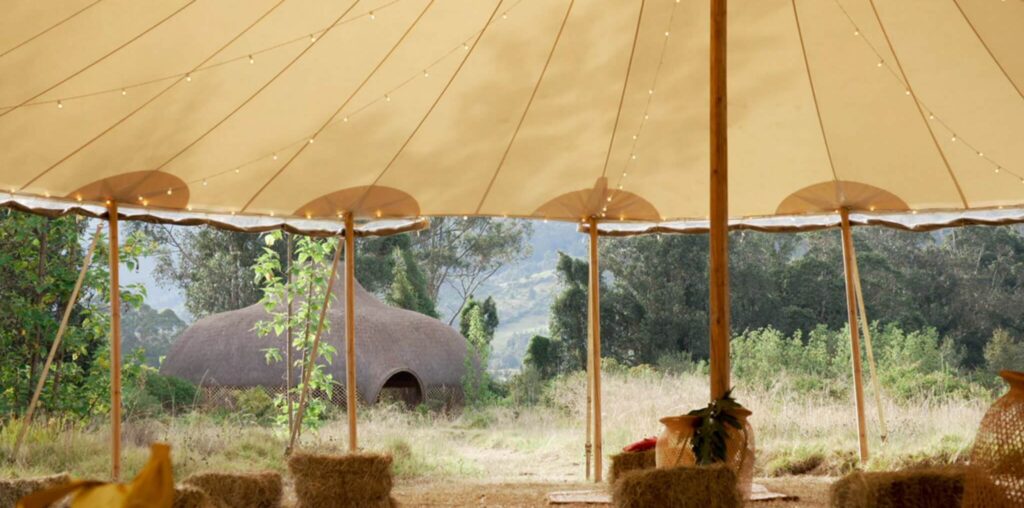From October 31 to November 2 in Bogotá and Tenjo, Colombia, I joined a group of artists, activists, architects, and curators, among other guests, at the Architectures of Planetary Well-Being biannual symposium. The event was organized—free and open to the public—by re:arc institute, a Copenhagen-based architectural nonprofit. For the past three years, it has been working to enable climate action by funding site-specific projects and radical pedagogies around architecture.
This conference was centered around the Andean concept of “buen vivir” (well-being), which honors the interdependence of species with their land and reclaims Indigenous identity and territory. The first two days were hosted at the cultural center Casa Lolita in Bogotá, and the third took place in Tenjo, a town on the Bogotá savanna east of the Andes, at Fundación Organizmo, an education center led by architect Ana María Gutiérrez that is focused on low-impact building techniques, intercultural knowledge, and ecological restoration.
Day one began with an awareness of our bodies among flower altars and viche, an ancestral drink made by Afro-Colombian women from the Pacific Coast. Following this ritual, equity-based journalist Sher Herrera moderated a conversation on the non-western concepts of ubuntu (“I am because we are,” in South African philosophy) and buen vivir, with Black rights activist Marilyn Machado Mosquera and Catherine Dunga, cofounder of the nonprofit African art organization Kitambo.

Facilitated within the framework of architecture—yet with no clear remarks on spatial practices—this initial gathering was not easy to grasp. It required a voluntary act of unlearning and deep listening from the audience, myself included, with respect to the pluralistic approach of what architecture can represent as social, ecological, and cultural infrastructure.

The following day, architecture and its discourse became more immediately legible. A series of 20-minute presentations provided a window into punctual examples of urban regeneration, participatory design, and self-built communities. Brazilian architect Gabriela de Matos spoke of quilombos—where enslaved people once retreated to—as Afro-Brazilian places of resistance and knowledge for contemporary architecture models; Oasis Urbano highlighted the self-built neighborhood of Moravia, rooted on a former landfill in Medellín; and Island City Lab described themselves as “observers working in solidarity” with the Cassava Piece community in Kingston, Jamaica, particularly on self-organized waste management systems.

Other panelists emphasized the need for radical pedagogical approaches, like Arquitectas Colombianas’ call for the visibility of women in construction and architecture, and WAI Think Tank’s anti-racist architecture education models. Cruz García, the Puerto Rican half of WAI, said they tend to be very confrontative with institutions, “I’m always thinking, ‘today is the day I get fired’,” he said of his appointment at Iowa State University, a risk he is willing to take in order to enact radical change in a state that has banned critical race theory.

The impact of politics of care in rural and urban settings was especially evident in two instances. In Colombia, as in most of Latin America, the average life expectancy for trans women is 35 years. Red Comunitaria Trans, a group of sex workers recently expelled from the streets of Bogotá’s Santa Fe neighborhood where they lived, shared how they relocated to the countryside to build a communal home where they live without fear and age gracefully with their sisters. And Comunal, an architectural practice based in Mexico, is helping rural communities continue to build through mutual aid and according to ancestral knowledge. They listen to each group’s needs, from infancy to old age, and provide aid in urgent infrastructure like safe birthing houses built with and for the community.
These outcomes take long periods of observation and learning, something re:arc, backed by the Interogo Foundation, has been able to provide through unique grant models. “Something is changing in philanthropy specifically led by women…. We are given more funds and more freedom to iterate [at our own pace,]” Gabriella Gómez-Mont, a Mexican creative urbanist and re:arc Public Discourse grantee, told me over one of many nourishing meals during the symposium.
Dorraine Duncan, executive director at Island City Lab described to me how re:arc, to their surprise, approached them directly and provided much needed time to build up their project through a Practice Lab grant. And these are not just a few hundred dollars: Public Discourse grantees receive €30,000 ($31,600) on average, and the Practice Lab Grant tops out at €250,000 ($264,000).

A third grant format is reserved for established nonprofits like Fundación Organizmo, where the last day of the symposium took place. Here, visitors participated in workshops on biodynamic agriculture, ecological restoration, and earthen construction techniques like mixing thick clay up to your elbows to make adobe bricks and experimenting with wattle and daub structures. Organizmo works as a practice lab, but the actual work is done in support of local initiatives throughout the Colombian native territories.
A common thread among the symposium’s participants is a constant resistance to established Western and patriarchal norms. Alice Grandoit-Šutka, cofounder of re:arc and director of its Public Discourse program, told me this type of work can feel isolating. “My hope is that [these symposiums] become larger networks of solidarity between all of these practitioners, and that participants realize that they’re a part of a larger network of change and can facilitate more opportunities to connect with each other.”
Natalia Torija Nieto is a freelance architecture and design writer based in New York.

